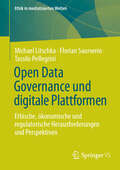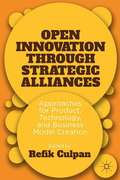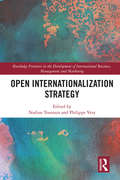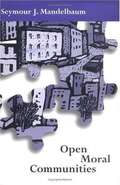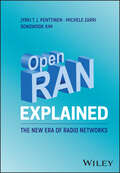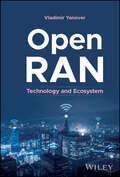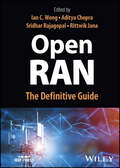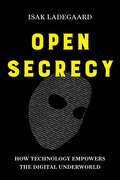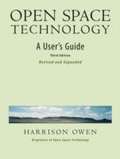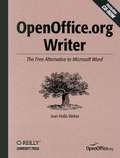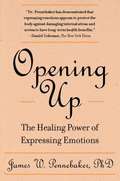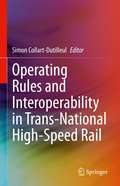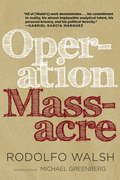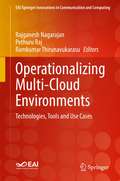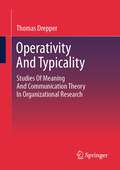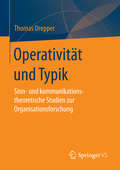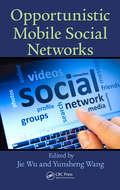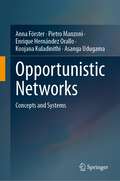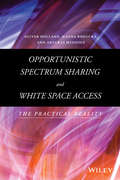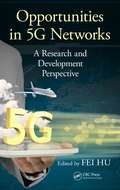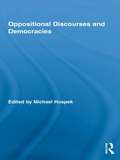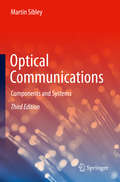- Table View
- List View
Open Data Governance und digitale Plattformen: Ethische, ökonomische und regulatorische Herausforderungen und Perspektiven (Ethik in mediatisierten Welten)
by Tassilo Pellegrini Michael Litschka Florian SaurweinDieses Buch behandelt ethische, ökonomische und regulatorische Aspekte der Open Data Governance bei digitalen Plattformen. Wie Unternehmen der digitalen Ökonomie mit offenen Daten umgehen, wirft viele gesellschaftlich relevante Fragen auf: Wie können offene Daten und der darauf beruhende Content möglichst weit in der Bevölkerung verbreitet werden? Wie kann Content Moderation transparent organisiert und wie können Dateninfrastrukturen sozial erwünscht gestaltet werden? Das Buch analysiert die Fallstudien offene digitale Public-Value Plattformen, offene digitale Dateninfrastrukturen und Content Moderation und Kuratierung auf digitalen Plattformen und entwickelt Governance-Modelle, die eine Beurteilung verschiedener Regulierungsmöglichkeiten für Unternehmen der digitalen Plattformökonomie ermöglichen.
Open Innovation through Strategic Alliances
by Refik CulpanOpen Innovation through Strategic Alliances demonstrates the vital role and applications of strategic alliances in organizations when creating and applying knowledge for the development of new products, technologies, or business models. This edited collection builds solid knowledge sources and insights into understanding open innovation through inter-organizational alliances. Culpan provides readers with a clear and comprehensive understanding of the utilization of inter-firm partnerships in realizing firm innovation, which is considered crucial for achieving long-term growth and competitive advantage. This book is a valuable tool for understanding the theoretical and practical insights of open innovation business models using strategic alliances.
Open Internationalization Strategy (Routledge Frontiers in the Development of International Business, Management and Marketing)
by Nadine Tournois; Philippe VeryOpen internationalization is a concept that brings a new perspective on the process of firm internationalization. As theories of internationalization show, some companies expand abroad only on their own, known as closed internationalization, while others combine their resources with those of other firms or use their networks for facilitating foreign implantation, known as open internationalization. Parallel to the development of the well-known concept of open innovation, open internationalization can be conceived as a meta-model for understanding companies’ expansion abroad. This book gathers a selection of contemporary research works dedicated to open internationalization, either seen as a way to analyze expansion in foreign countries, or as a way to investigate the management of geographically dispersed activities. All the authors of the chapters are researchers specialized in the internationalization field. Readers will benefit from this new lens for understanding, studying or practising international business, from the decision to go abroad to its implementation and its efficiency. Open Internationalization Strategy includes both academic empirical investigations and literature reviews on specific topics, making it valuable to researchers, academics, managers, and students in the fields of business and management history, international business, organizational studies, and economics.
Open Moral Communities
by Seymour J. MandelbaumSeymour Mandelbaum's extended reflection on communities and the myths that sustain them is a plea for a communitarian sensibility. Communities are critically important in maintaining and adapting public moral orders.
Open RAN Explained: The New Era of Radio Networks
by Jyrki T. Penttinen Michele Zarri Dongwook KimOpen RAN EXPLAINED A pioneering outline of the concepts that enhance 5G capabilities to revolutionize the telecommunications industry. Open radio-access network, or Open RAN, is a type of network architecture in which baseband and radio unit components from different suppliers can operate seamlessly in concert. Advances in network communication were, until recently, hampered by the proprietary network operations of each mobile operator; the advent of 5G, however, with its service-based architecture model, has finally opened the door to the expansion of connectivity on the Open RAN model. This transformation promises to define the future of mobile network architecture. Open RAN Explained is among the first books dedicated to this groundbreaking technology. Its comprehensive but accessible summary of current and future developments in Open RAN promises to facilitate network deployment and device design, as well as to provide a handy reference for network professionals in a range of different fields. The result is a must-read volume for anyone looking to understand the future of wireless communication. Open RAN Explained readers will also find: In-depth description of the challenges and opportunities of network modularizationAnalysis conversant with the latest release specifications of the O-RAN Allliance, GSMA OP/TIP, and other key emerging technologiesAuthors working at the leading edge of 5G network communications Open RAN Explained is ideal for network operators, network element and device manufacturers, telecommunications researchers, and advanced students, as well as industry-adjacent figures such as regulators, consultants, and marketing professionals.
Open RAN: Technology and Ecosystem
by Vladimir YanoverComplete guide to identifying and describing basic Open RAN technology concepts and understanding the structure and dynamics of the ecosystem Open RAN describes key aspects and provides insight into the structure and dynamics of the Open RAN ecosystem, linking the key technology aspects to the market drivers and showing the role of technology in the ecosystem's progress. This book explores Open RAN cloudification techniques and deployment scenarios down to details of the RAN split options and use of hardware accelerators. Open RAN programmability for non-real-time operations (SMO, Non-RT RIC, A1) and real-time operations (Near-RT RIC, E2) are discussed alongside essentials of RAN control, network data collection, notifications of events, policy control, and network and service management. Examples of implementation by leading vendors and open-source communities are provided throughout to show the potential of the Open RAN ecosystem and technology. Written by an industry insider and a key contributor to the development of the technology, this book includes: Activities and structure of the O-RAN Alliance, including work groups, committees, and the O-RAN Software Community (OSC) Evolution of the Open RAN ecosystem, covering O-RAN specifications releases and compliant products, ongoing and planned developments, as well as ongoing and planned trials and commercial deployments SMO and Non-RT RIC functional procedures, A1 policy-based interface, rApps Near-RT RIC functional procedures, covering subscription, notifications, control, policy, and query procedures; E2 services, covering REPORT, INSERT, CONTROL, and POLICY services; Near-RT RIC as an xApps hosting platform Traffic steering, QoS optimization, NSSI resource optimization, and massive MIMO optimization, covering outer and inner control loops, network data collection, and optimization actions With a combined overview of key technology aspects and practical examples, Open RAN is a practical and highly useful reference for researchers, engineers, and marketing experts employed by mobile carriers, equipment vendors, government bodies, and universities, as well as professionals in associated communications fields and PhD electrical engineering students.
Open RAN: The Definitive Guide
by Ian C. Wong Aditya Chopra Sridhar Rajagopal Rittwik JanaOpen RAN A comprehensive survey of Open RAN technology and its ecosystem In Open RAN: The Definitive Guide, a team of distinguished industry leaders deliver an authoritative guide to all four principles of the Open RAN vision: openness, virtualization, intelligence, and interoperability. Written by the industry experts currently defining the specifications, building the systems, and testing and deploying the networks, the book covers O-RAN architecture, the fronthaul interface, security, cloudification, virtualization, intelligence, certification, badging, and standardization. This critical reference on Open RAN explains how and why an open and disaggregated, intelligent, and fully virtualized network is the way networks should be designed and deployed moving forward. Readers will also find: A thorough introduction from key industry players, including AT&T, Telefonica, Mavenir, VMWare, Google and VIAVI Comprehensive explorations of Open X-Haul transport networks and other unique 5G capabilities Practical discussions of the four pillars of O-RAN architecture: openness, virtualization, intelligence, and interoperability Comprehensive treatments of how smaller vendors can introduce their own services and customize the network Perfect for engineers, product managers, and marketing professionals in the telecom industry, Open RAN: The Definitive Guide will also benefit graduate students, researchers, and engineers in government agencies with involvement in the wireless and telecom industries.
Open Secrecy: How Technology Empowers the Digital Underworld
by Isak LadegaardExamines how the global digital underground is liberated by "open secrecy"—a novel and ominous mix of tools for mass communication and anonymity Shadowy groups are increasingly capable of collective action. Using military-grade encryption, rerouting software, and cryptocurrencies, anonymous and pseudonymous actors can now communicate, solve problems, recruit members, and manage resources across multiple public and semipublic spaces. This swirling mix of secrecy and openness enables people to move through cyberspace like nomads with verifiable personas, which makes them impossible to stop. Isak Ladegaard takes readers inside a dark, digital economy for banned drugs that has survived numerous police crackdowns, examines how activist software developers in China and other countries have maintained paths to the open internet, and documents how the American far right uses the same tools to sustain antisocial movements based on paranoia and hate. Timely and perceptive, Open Secrecy argues that although information technology enables mass surveillance, it also undermines state power by boosting groups that evade its rule. These dual forces of control and liberation are propelling us forward, with no one at the wheel.
Open Space Technology: A User's Guide (3rd edition)
by Harrison OwenWhat if you could identify a mission-critical issue for your organization, bring together the people with something to contribute and something at stake, focus on that issue and take decisive action all in the same meeting? A fantasy? Not with the application of Open Space Technology. Open Space Technology is a methodological tool that enables self-organizing groups of all sizes to deal with hugely complex issues in a very short period of time. Authored by the originator of Open Space Technology, Open Space Technology: A User's Guide details what needs to be done before, during, and after an Open Space event. It is the most authoritative book available on how to plan and run a successful Open Space event. This 3rd edition adds a survey of the current status of Open Space Technology around the world, an updated section on the latest available technology for report writing (a key aspect of the Open Space process), and an updated list of resources.
Open Standards and the Digital Age
by Andrew L. RussellHow did openness become a foundational value for the networks of the twenty-first century? Open Standards and the Digital Age answers this question through an interdisciplinary history of information networks that pays close attention to the politics of standardization. For much of the twentieth century, information networks such as the monopoly Bell System and the American military's Arpanet were closed systems subject to centralized control. In the 1970s and 1980s, however, engineers in the United States and Europe experimented with design strategies to create new digital networks. In the process, they embraced discourses of "openness" to describe their ideological commitments to entrepreneurship, technological innovation, and participatory democracy. The rhetoric of openness has flourished - for example, in movements for open government, open source software, and open access publishing - but such rhetoric also obscures the ways the Internet and other "open" systems still depend heavily on hierarchical forms of control.
Open to Outcome: A Practical Guide for Facilitating & Teaching Experiential Reflection (2nd Edition)
by Micah Jacobson Mari RuddyWith the first edition of Open to Outcome, tens of thousands of educators and learners experienced and benefited from The 5 Questions model for facilitating reflective discussions. This second edition builds on the solid foundation of the first, offering ingeniously simple changes to the 4th and 5th questions, the addition of a new chapter on specific outcomes, and other updates to make this proven processing method even more powerful and effective.
OpenOffice.org Writer
by Jean Hollis WeberThanks to OpenOffice.org, there is an alternative to Microsoft Word. If you've ever been frustrated by Word's quirks and limitations--including its price tag--and longed for a practical alternative, then it's time to break free. OpenOffice.org is the free, open source office suite and its word processor, Writer, has proven extremely popular with both Windows and Linux users. How good can it be if it's free? you might ask. And how much trouble will it be to install and learn? A quick tour of the program will show you: the features you use regularly--from formatting and spell check to using templates and creating indexes --are all there. And Writer's intuitive, surprisingly familiar interface lets you navigate with ease. To quickly master the ins and outs of Writer, you'll want a copy of OpenOffice.org Writer: The Free Alternative to Microsoft Word . This handy reference is packed with essential information to help you learn the basics of Writer and become adept with its advanced features. Written for intermediate and advanced users of word processing programs, OpenOffice.org Writer: The Free Alternative to Microsoft Word provides guidance for common and advanced word processing tasks. With this book, you'll learn how to: Set up OOoWriter to work your way Write, edit, and review documents Control page layout Use templates and styles effectively Get the most from using fields Work with Tables of contents, indexes, bibliographies Manage large or complex documents Insert, edit and create graphics Make a smooth transition from Microsoft Word OpenOffice.org Writer: The Free Alternative to Microsoft Word provides guidance for anyone who wants to break out of the Word rut. Its detailed Table of Contents make it a handy reference for even the most experienced word processing users who want to get up to speed quickly with this program, or make sure they're taking full advantage of OOo Writer's features. With the complete office suite included on a CD (which you can install on as many machines as you like), this book makes using Writer an easy decision. OpenOffice.org Writer: The Free Alternative to Microsoft Word is part of the O'Reilly Community Press Series. Unlike classic O'Reilly animal books, O'Reilly's role in the series is limited to providing manufacturing and distribution services rather than editorial development, so that each Community Press title reflects the editorial voice and organization of the community that has created it.
Opening Up: The Healing Power of Expressing Emotions
by James W. PennebakerUsing original research, Dr. James Pennebaker presents astounding evidence for the health benefits of personal self-disclosure, offering sound advice on how each of us can confront and conquer buried turmoil and get on the road to good health.
Operating Rules and Interoperability in Trans-National High-Speed Rail
by Simon Collart-DutilleulThis book examines the problem of interoperability related to operating rules and gives an overview of the formal method approaches related to this subject. The book examines the interoperability issues concerning implementation of European Rail Traffic Management System (ERTMS) while crossing a boarder. It also looks at the implementing of the ERTMS and provides solutions regarding operating rules for ERTMS lines, using formal methods and simulation tools. The contributors will also discuss operating rule validation and formal methods for safety assessment.
Operation Massacre
by Michael Greenberg Ricardo Piglia Rodolfo Walsh Daniella Gitlin1956. Argentina has just lost its charismatic president Juán Perón in a military coup, and terror reigns across the land. June 1956: eighteen people are reported dead in a failed Peronist uprising. December 1956: sometime journalist, crime fiction writer, studiedly unpoliticized chess aficionado Rodolfo Walsh learns by chance that one of the executed civilians from a separate, secret execution in June, is alive. He hears that there may be more than one survivor and believes this unbelievable story on the spot. And right there, the monumental classic Operation Massacre is born.Walsh made it his mission to find not only the survivors but widows, orphans, political refugees, fugitives, alleged informers, and anonymous heroes, in order to determine what happened that night, sending him on a journey that took over the rest of his life.Originally published in 1957, Operation Massacre thoroughly and breathlessly recounts the night of the execution and its fallout.From the Trade Paperback edition.nformers, and anonymous heroes, in order to determine what happened that night, sending him on a journey that took over the rest of his life.Originally published in 1957, Operation Massacre thoroughly and breathlessly recounts the night of the execution and its fallout.
Operationalizing Multi-Cloud Environments: Technologies, Tools and Use Cases (EAI/Springer Innovations in Communication and Computing)
by Pethuru Raj Rajganesh Nagarajan Ramkumar ThirunavukarasuThis book discusses various aspects of the multi-cloud paradigm. The initial portion of the book focuses on the motivations for the industry to embrace a multi-cloud option and the distinct business, technology, and user cases of multi-cloud implementations. The middle part of the book explains the challenges of setting up and sustaining multi-cloud environments. The latter portion focuses on the next-generation technologies and tools along with multi-cloud platforms, processes, patterns, and practices. The final segment of the book is dedicated for cloud brokerage systems. The various traits and tenets of cloud brokerage services especially for accomplishing cloud intermediation, integration, orchestration, governance, security, management, configuration, etc. are explained in detail. The book also clearly articulates how to have intelligent brokers.
Operativity And Typicality: Studies Of Meaning And Communication Theory In Organizational Research
by Thomas DrepperThe present text discusses sense-theoretical foundations of recent organizational research and makes them visible by analyzing epistemological terms of current discourses in organizational science (cognition, institution, practice, culture, communication, semantics). In a further step, communication is discussed as an operative guiding concept for understanding organizational reproduction and networking and applied to various organizational phenomena (managementization, standardization, circulation of ideas, translation, design). This book thus sees itself both as a contribution to theory development in organizational research and as a contribution to the research field of "(world) society and organization." Overall, the individual studies in this text discuss and explore the relevance of an epistemological, social and societal foundation of organization theory on the basis of an operational theory of meaning.This book is a translation of an original German edition. The translation was done with the help of artificial intelligence (machine translation by the service DeepL.com). A subsequent human revision was done primarily in terms of content, so that the book will read stylistically differently from a conventional translation.
Operativität und Typik
by Thomas DrepperDer vorliegende Text diskutiert sinntheoretische Grundlagen der neueren Organisationsforschung und macht diese durch die Analyse erkenntnisleitender Begriffe aktueller organisationswissenschaftlicher Diskurse (Kognition, Institution, Praxis, Kultur, Kommunikation, Semantik) sichtbar. In einem weiteren Schritt wird Kommunikation als operativer Leitbegriff zum Verständnis organisationaler Reproduktion und Vernetzung diskutiert und auf verschiedene Organisationsphänomene (Managementisierung, Standardisierung, Ideenzirkulation, Übersetzung, Design) angewendet. Dieses Buch versteht sich damit sowohl als ein Beitrag zur Theorieentwicklung in der Organisationsforschung als auch als ein Beitrag im Forschungsfeld „(Welt-)Gesellschaft und Organisation“. Insgesamt wird in den Einzelstudien dieses Textes die Relevanz einer erkenntnis-, sozial- und gesellschaftstheoretischen Fundierung der Organisationstheorie auf Basis einer operativen Sinntheorie diskutiert und ausgelotet.
Opportunistic Mobile Social Networks
by Jie Wu Yunsheng WangThe widespread availability of mobile devices along with recent advancements in networking capabilities make opportunistic mobile social networks (MSNs) one of the most promising technologies for next-generation mobile applications. Opportunistic Mobile Social Networks supplies a new perspective of these networks that can help you enhance spontaneo
Opportunistic Networks: Concepts and Systems
by Anna Förster Pietro Manzoni Enrique Hernández Orallo Koojana Kuladinithi Asanga UdugamaThis textbook provides an exhaustive exploration of Opportunistic Networks (OppNets). Divided into three parts, it starts with the foundational principles and metrics of OppNets, detailing their mobility and data dissemination. Significant focus is given to the security challenges faced by OppNets, including strategies to counter various attacks. The second part evaluates OppNets, introducing methods and metrics for assessment, theoretical and simulation models, and tools such as OMNeT++, The ONE and ns-3.This textbook also offers comparative analyses and discussions on benchmarking. The third part delves into the implementation of OppNets, discussing technologies from Mobile Ad Hoc Networks to satellite communication and their integration with cellular technologies like 4G, 5G and 6G. Detailed insight into device characterization reveals the potential and limitations of devices within OppNets. Practical applications of OppNets in scenarios such as disaster management, remotecommunication, IoT challenges, smart cities and satellite networks are presented as well. Through detailed discussions and case studies, readers gain a comprehensive understanding of the structure, operation and practical implications of OppNets. It equips readers with knowledge to appreciate the vast potential of OppNets in various applications and settings.This textbook targets advanced-level students and postdocs in computer science and electrical engineering as well as researchers, who are starting new in the area and need a comprehensive view of opportunistic networks. Practitioners who are interested in applying the concepts of opportunistic networks in their products and services, and would like to have a jump start into the development and applications of opportunistic networks will also want to purchase this book as a reference.
Opportunistic Spectrum Sharing and White Space Access
by Arturas Medeisis Oliver Holland Hanna BoguckaDetails the paradigms of opportunistic spectrum sharing and white space access as effective means to satisfy increasing demand for high-speed wireless communication and for novel wireless communication applications This book addresses opportunistic spectrum sharing and white space access, being particularly mindful of practical considerations and solutions. In Part I, spectrum sharing implementation issues are considered in terms of hardware platforms and software architectures for realization of flexible and spectrally agile transceivers. Part II addresses practical mechanisms supporting spectrum sharing, including spectrum sensing for opportunistic spectrum access, machine learning and decision making capabilities, aggregation of spectrum opportunities, and spectrally-agile radio waveforms. Part III presents the ongoing work on policy and regulation for efficient and reliable spectrum sharing, including major recent steps forward in TV White Space (TVWS) regulation and associated geolocation database approaches, policy management aspects, and novel licensing schemes supporting spectrum sharing. In Part IV, business and economic aspects of spectrum sharing are considered, including spectrum value modeling, discussion of issues around disruptive innovation that are pertinent to opportunistic spectrum sharing and white space access, and business benefits assessment of the novel spectrum sharing regulatory proposal Licensed Shared Access. Part V discusses deployments of opportunistic spectrum sharing and white space access solutions in practice, including work on TVWS system implementations, standardization activities, and development and testing of systems according to the standards. Discusses aspects of pioneering standards such as the IEEE 802.22 "Wi-Far" standard, the IEEE 802.11af "White-Fi" standard, the IEEE Dynamic Spectrum Access Networks Standards Committee standards, and the ETSI Reconfiguration Radio Systems standards Investigates regulatory and regulatory-linked solutions assisting opportunistic spectrum sharing and white space access, including geo-location database approaches and licensing enhancements Covers the pricing and value of spectrum, the economic effects and potentials of such technologies, and provides detailed business assessments of some particularly innovative regulatory proposals The flexible and efficient use of radio frequencies is necessary to cater for the increasing data traffic demand worldwide. This book addresses this necessity through its extensive coverage of opportunistic spectrum sharing and white space access solutions. Opportunistic Spectrum Sharing and White Space Access: The Practical Reality is a great resource for telecommunication engineers, researchers, and students.
Opportunities in 5G Networks: A Research and Development Perspective
by Fei HuOpportunities in 5G Networks: A Research and Development Perspective uniquely focuses on the R&D technical design of 5th-generation (5G) networks. It is written and edited by researchers and engineers who are world-renown experts in the design of 5G networks. The book consists of four sections: The first section explains what 5G is, what its re
Oppositional Discourses and Democracies (Routledge Studies in Social and Political Thought)
by Michael HuspekWhen citizens take to the streets or pack assembly halls or share their ideas through the minority press, they often give voice to truths and logic that have otherwise been given little or no airing through the available institutional channels offered by democratic states. Such discourses offer new rhetorical strategies for the expression of citizen desires, needs and emotions that otherwise go unrecognized and unaddressed. They also offer impetus for new forms of deliberation and informed action that can result in real political change. This collection explores the tensions between democratic states and the dynamics of citizen voice. In so doing, the collection addresses such questions as: What role do oppositional discourses play in increased democratization? Can oppositional discourses be sustained over time? How do states resist pressures to democratize? This volume will be of interest to students and scholars in Politics, Sociology, and Communication.
Optical Code Division Multiple Access
by Ken-Ichi KitayamaA comprehensive guide to optical fiber communications, from the basic principles to the latest developments in OCDMA for Next-Generation Fiber-to-the-Home (FTTH) systems. Part I starts off with the fundamentals of light propagation in optical fibers, including multiple access protocols, and their enabling techniques. Part II is dedicated to the practical perspectives of Next-Generation Fiber-to-the-Home (FTTH) technology. It covers the key building blocks of OCDMA, devices such as optical encoders and decoders, signal impairments due to noise, and data confidentiality, a unique property of OCDMA. This is followed by hybrid system architectures with TDM and WDM and practical aspects such as system cost, energy efficiency and long-reach PONs. Featuring the latest research, with cutting-edge coverage of system design, optical implementations, and experimental demonstrations in test beds, this text is ideal for students, researchers and practitioners in the industry seeking to obtain an up-to-date understanding of optical communication networks.
Optical Communications: Components and Systems
by Martin SibleyThe long-awaited third edition of this classic textbook provides a genuinely accessible introduction to the principles and technology of optical communication systems. It takes the reader from the fundamentals of light propagation in optical fibre, through materials and fabrication methods, light sources and modulation, to photodiodes and receiver design, and concludes with a chapter looking at system level integration.Updated throughout, major changes for this third edition include:- coverage of advanced semiconductor laser diode structures (VCSELs and DFBs)- an extended section on fibre amplifiers and lasers- updated discussion of avalanche photodiode structures- expanded coverage of transimpedance and optical preamplifiers- new sections on free-space optical links, VLC, ethernet links, coherent detection and terabit systemsEnhanced with worked examples and end-of-chapter problem sets, the book is aimed at advanced undergraduate and graduate students in electronic engineering, optical science and applied physics, and is ideally suited for adoption as a course text.
